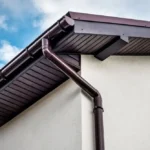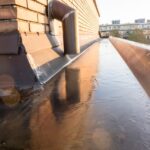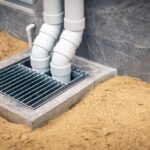Every homeowner knows the importance of maintaining their home, and one area that often requires attention is the roof. Ensuring that rainwater flows freely off your roof is crucial to preventing water damage, leaks, and other costly repairs. In this article, we will explore how to remove roof drainage blockages effectively and maintain the health of your home’s roofing system.
When it comes to maintaining a home, roof drainage often gets overlooked. However, it plays a vital role in protecting your property from water damage. Let’s delve into the essential steps and techniques to keep your roof drainage system in top shape.

Understanding Roof Drainage Systems
A roof drainage system is designed to manage water runoff from your roof, directing it away from the structure of your home. This system typically consists of gutters, downspouts, and drains. Proper maintenance of this system is crucial to avoid blockages that can cause significant damage over time.
Importance of Regular Maintenance
Regular maintenance of your roof drainage system ensures that water flows smoothly and doesn’t accumulate, leading to potential leaks and damage. Homeowners should make it a priority to inspect and clean their drainage systems at least twice a year.
Common Causes of Blockages
Blockages in roof drainage systems are often caused by a variety of factors, including fallen leaves, twigs, debris, and even bird nests. Understanding these common causes will help you prevent and address blockages more effectively.
Steps to Remove Roof Drainage Blockages
1. Safety First
Before attempting to clear any blockages, ensure you prioritize safety. Use a sturdy ladder, wear non-slip shoes, and, if possible, have someone assist you.
2. Inspect the Gutters
Begin by inspecting the gutters for any visible debris or blockages. Use a trowel or gloved hands to remove any accumulated debris carefully.
3. Check Downspouts
Downspouts play a crucial role in directing water away from your home. Use a garden hose to flush out any debris that might be causing a blockage in the downspouts.
4. Use a Plumbing Snake
For stubborn blockages, a plumbing snake can be a valuable tool. Insert the snake into the downspout and turn it clockwise to dislodge any debris.
5. Rinse and Test
After clearing the blockages, rinse the gutters and downspouts with a garden hose to ensure water flows freely. This step will also help you identify any remaining issues.
Preventing Future Blockages
Install Gutter Guards
To minimize the risk of future blockages, consider installing gutter guards. These protective devices prevent debris from entering the gutters while allowing water to flow freely.
Trim Overhanging Branches
Keeping trees and branches trimmed away from your roof can significantly reduce the amount of debris that accumulates in your gutters.
Regular Inspections
Schedule regular inspections of your roof drainage system to catch potential blockages early and address them before they cause significant problems.
Professional Assistance
If you’re unsure about handling roof drainage maintenance yourself, consider hiring a professional. A qualified expert can provide thorough inspections and cleaning services, ensuring your system remains in optimal condition.
For more detailed tips on inspecting roof drainage systems, you can visit roof-home.com.
Additional Resources
For further information on maintaining your roof drainage system, check out this external resource that offers valuable insights into residential flat roof drainage solutions.

Frequently Asked Questions
1. How often should I clean my roof drainage system?
It’s recommended to clean your roof drainage system at least twice a year, preferably in the spring and fall, to prevent blockages and ensure proper water flow.
2. What tools do I need to clear blockages?
Basic tools include a sturdy ladder, gloves, a trowel, a garden hose, and a plumbing snake for stubborn blockages.
3. Can blockages cause roof damage?
Yes, blockages can cause water to accumulate, leading to leaks and potential damage to your roof and home’s structure. Regular maintenance is essential to prevent such issues.
For more insights on managing roof drainage, visit roof-home.com.
This article contains affiliate links. We may earn a commission at no extra cost to you.







